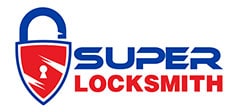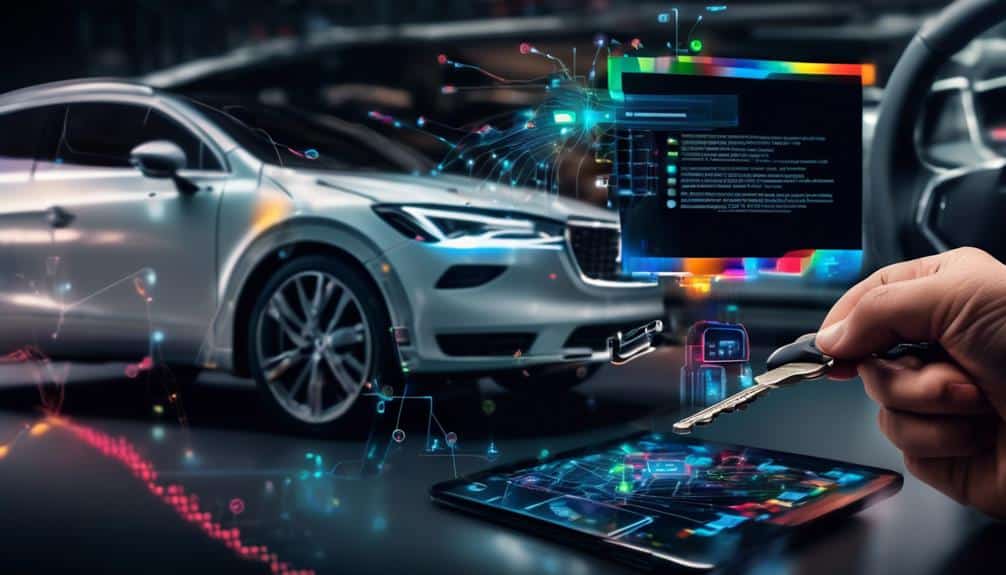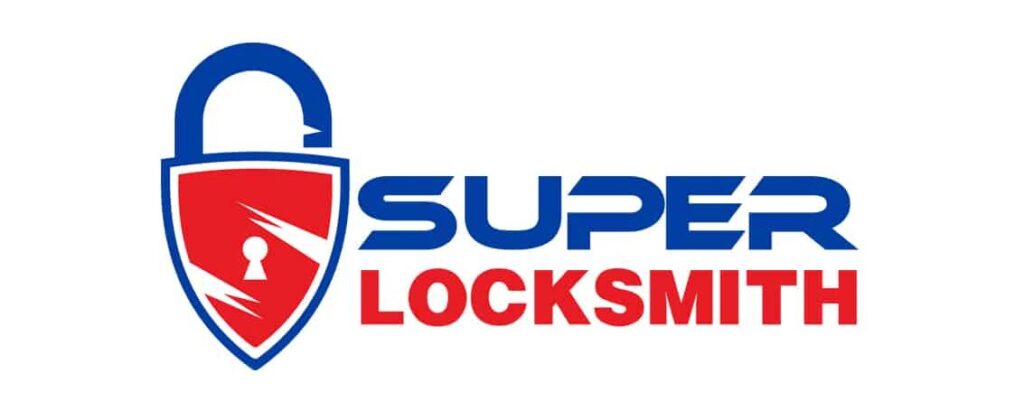Have you ever wondered about the intricate process involved in remote key programming? It may seem like a mysterious and complex task, but fear not, for we are here to shed light on this fascinating subject.
From the initial consultation to the final programming steps, each stage plays a crucial role in ensuring the seamless functionality of your remote key.
So, buckle up and prepare to embark on a journey that will unravel the secrets behind this essential automotive service.
Initial Consultation

During the initial consultation, you'll have the opportunity to discuss your remote key programming needs with our knowledgeable team. At this stage, it's important to determine the vehicle compatibility for remote key programming. Our team will ask you for detailed information about your vehicle's make, model, and year to ensure that we can provide the appropriate remote key programming solution. This information allows us to identify the correct programming method and equipment required for your specific vehicle.
Additionally, the initial consultation is a great time to address any troubleshooting concerns you may have. Our team is well-versed in common remote key programming issues and can provide you with helpful troubleshooting tips. Whether you're experiencing difficulties with your existing remote key or have concerns about compatibility with aftermarket components, our team will provide you with expert advice and guidance.
Vehicle Identification
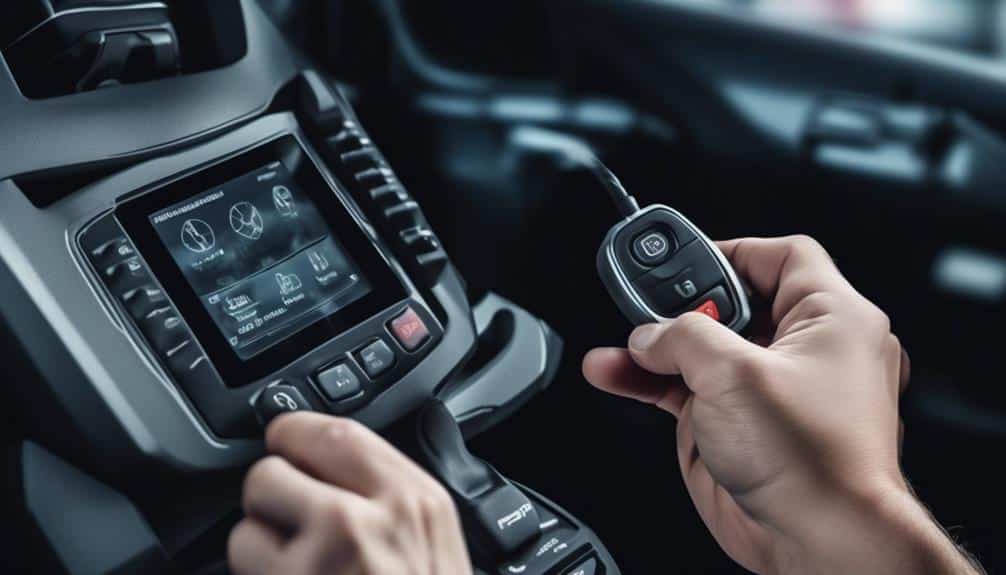
To begin the discussion on vehicle identification, there are three key points to consider:
- VIN verification: First, you need to verify the Vehicle Identification Number (VIN) to ensure that you're working with the correct vehicle.
- Key code retrieval: Next, you'll retrieve the key code, which is essential for programming the remote.
- Remote programming steps: Finally, you'll follow a series of steps to program the remote and synchronize it with the vehicle's electronic system.
VIN Verification
You can verify the Vehicle Identification Number (VIN) as part of the remote key programming process. This step is crucial to ensure that the correct key is programmed to your vehicle.
Here are three important things to know about VIN verification in remote key programming:
- VIN Retrieval: The VIN can be found on the dashboard, driver's side door jamb, or on the vehicle registration documents. It's a unique 17-digit code that identifies your vehicle.
- VIN Matching: During the remote key programming process, the VIN is cross-checked to ensure it matches the vehicle being programmed. This helps prevent unauthorized key programming and protects against theft.
- Transponder Key Compatibility: The VIN verification also confirms the compatibility of the transponder key with your vehicle's immobilizer system. This ensures proper communication between the key and the vehicle's security system, allowing for successful key programming.
Key Code Retrieval
Key code retrieval is an essential step in the remote key programming process, allowing for accurate identification and programming of the correct key for your vehicle.
The key code is a unique sequence of numbers or letters that corresponds to your vehicle's lock system.
To retrieve the key code, you can consult your vehicle's documentation, such as the owner's manual or service history. Alternatively, you can contact the manufacturer or a professional locksmith who can access the key code database.
Once the key code is obtained, it needs to be verified to ensure its accuracy. Key code verification involves cross-referencing the retrieved key code with the vehicle's identification number (VIN) to confirm a match.
This is crucial to avoid programming the wrong key and potential issues with your vehicle's security system.
Remote Programming Steps
Now that the key code retrieval process has been completed, the next step in the remote key programming process is to identify the vehicle for programming. This step is crucial to ensure that the remote programming tools are compatible with the specific vehicle.
Here are three important steps to identify the vehicle for programming:
- Retrieve the vehicle identification number (VIN): The VIN is a unique identifier that provides information about the vehicle's make, model, and year. It can be found on the driver's side dashboard or on the driver's side door jamb.
- Consult the vehicle manufacturer's database: Using the VIN, access the manufacturer's database to verify the vehicle's specifications and programming requirements.
- Troubleshoot remote programming issues, if necessary: If there are any difficulties during the programming process, refer to the troubleshooting guide provided by the remote programming tool manufacturer. This guide will help diagnose and resolve common issues.
Key Code Retrieval
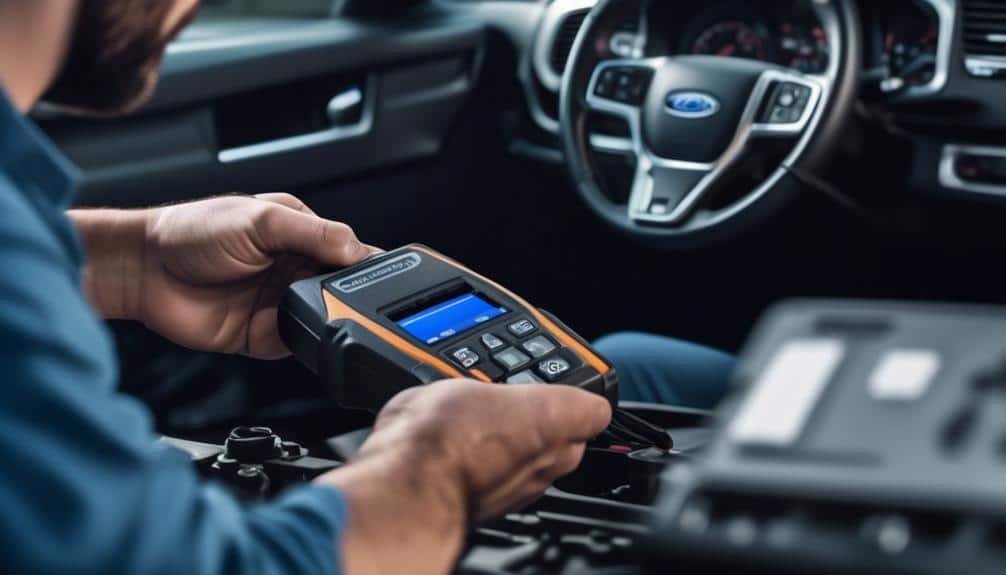
Now let's move on to the next step in the remote key programming process: key code retrieval.
This crucial process involves retrieving the unique key code for your vehicle.
Once the key code is obtained, it can be verified to ensure accuracy before proceeding to the key programming steps.
Retrieving Key Code
To retrieve the key code, you can optionally consult the vehicle's manufacturer or utilize a specialized key code retrieval tool.
Here are three steps to help you retrieve the key code efficiently:
- Initial Consultation: Contact the vehicle's manufacturer or a certified dealership to inquire about the availability of the key code. Provide them with the necessary information, such as the vehicle's make, model, and identification number.
- Key Code Retrieval Tool: If the manufacturer or dealership can't provide the key code, you can utilize a specialized key code retrieval tool. These tools are designed to communicate with the vehicle's onboard computer and extract the key code information. They're commonly used by professional locksmiths or automotive service technicians.
- Key Cutting: Once you have retrieved the key code, you can proceed to cut a new key using the code. This can be done by a locksmith or a key cutting service. Ensure that the new key is properly programmed and tested before use.
Key Code Verification
You can verify the key code by either consulting the vehicle's manufacturer or utilizing a specialized key code retrieval tool.
Key code verification is a crucial step in the remote key programming process as it ensures that the correct key code is being used to program the remote.
Consulting the vehicle's manufacturer is a reliable method to obtain the key code. They'll have access to the necessary information and can provide you with the accurate key code for your vehicle.
Alternatively, you can use a specialized key code retrieval tool. These tools are designed to retrieve the key code from the vehicle's immobilizer system, making the process quick and efficient.
Key Programming Steps
Key code retrieval is an essential step in the remote key programming process, ensuring that the correct key code is used for programming the remote.
To retrieve the key code, follow these steps:
- Identify the vehicle make and model: Before attempting key code retrieval, it's crucial to know the specific make and model of the vehicle. This information helps in finding the appropriate method for retrieving the key code.
- Consult the vehicle's documentation: Some vehicles come with a key code card or documentation that provides the key code. Check the owner's manual, service booklet, or any other relevant documents for this information.
- Contact the manufacturer or a locksmith: If the key code isn't readily available, reaching out to the vehicle manufacturer or a professional locksmith can be helpful. They often have access to databases or tools that can assist in retrieving the key code.
Remote Key Programming Equipment
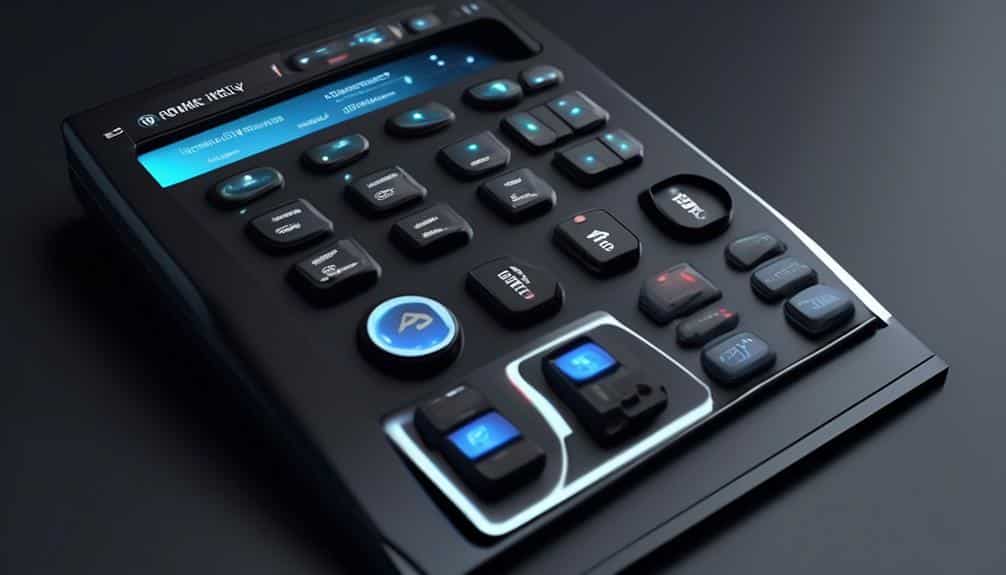
Using specialized equipment, remote key programming can be efficiently and effectively accomplished. Remote key programming equipment is designed to communicate with the vehicle's immobilizer system, allowing for the programming of new keys or the reprogramming of existing ones. This equipment is crucial for automotive locksmiths and dealerships to provide key programming services for their customers.
One essential tool used in remote key programming is a key programmer. This device is capable of reading the key code and programming the remote control functions of the key. It can also retrieve the vehicle's immobilizer code, which is necessary for programming new keys. Key programmers are available in various models, each designed to work with specific vehicle makes and models.
Another important piece of equipment is the transponder key programmer. This device is used to program transponder keys, which have a small electronic chip embedded in the key head. The transponder key programmer can read the chip's code and program it into the vehicle's immobilizer system, allowing the key to start the engine.
In addition to these key programming tools, a diagnostic scanner is often used to diagnose and troubleshoot any issues with the vehicle's immobilizer system. This scanner can communicate with the vehicle's onboard computer and retrieve error codes, enabling the technician to identify and resolve any problems that may prevent successful key programming.
To summarize, remote key programming equipment consists of key programmers, transponder key programmers, and diagnostic scanners. These tools are essential for automotive locksmiths and dealerships to provide efficient and accurate key programming services to their customers.
Key Cutting
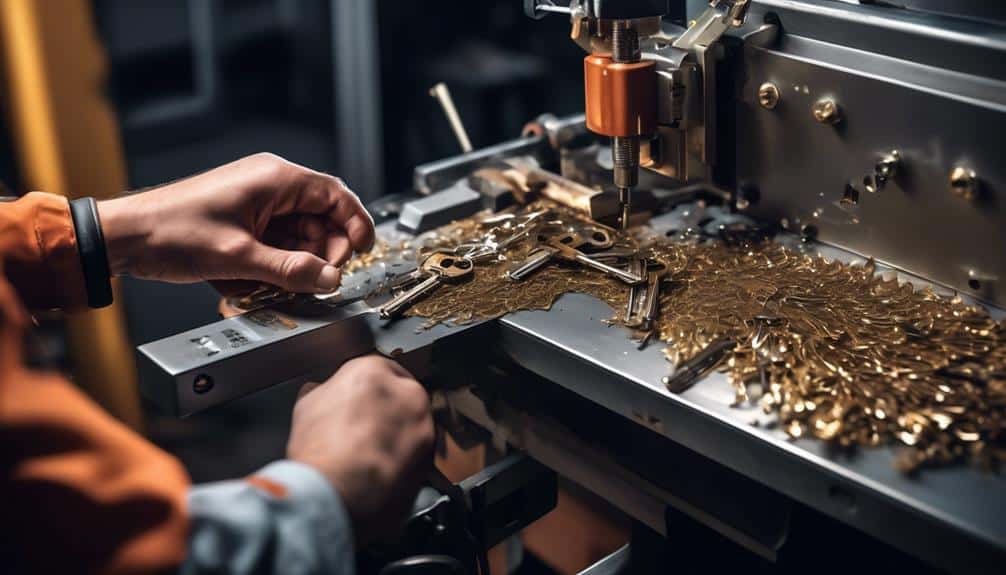
Now it's time to explore the process of key cutting.
Key cutting requires specific tools and follows a set of steps to ensure accuracy and functionality.
Understanding the tools and steps involved in key cutting is essential for successfully programming remote keys.
Tools for Key Cutting
To efficiently cut keys, it's essential to utilize a range of specialized tools. These tools are designed to ensure precision and accuracy in the key cutting process. Here are three key cutting tools commonly used in the industry:
- Key Cutting Machine: This machine is the core tool for cutting keys. It's equipped with different cutting blades and can accurately duplicate the shape and size of the original key.
- Key Gauge: A key gauge is used to measure the depth and spacing of the grooves in a key. It helps in determining the correct dimensions for cutting a new key.
- Key Clamps: Key clamps are used to securely hold the key in place during the cutting process. They ensure that the key remains stable, preventing any errors or inaccuracies.
Steps for Key Cutting
Begin the key cutting process by selecting the appropriate key cutting machine, key gauge, and key clamps for the specific key you're duplicating. Once you have gathered the necessary tools, follow these steps to ensure a successful key cutting process:
- Insert the original key into the key machine's clamp, making sure it's securely held in place.
- Use the key gauge to determine the precise measurements of the original key's cuts.
- Adjust the key machine's settings according to the key gauge measurements.
- Insert the blank key into the machine's clamp, ensuring it's positioned correctly.
- Activate the key machine to cut the duplicate key, following the machine's instructions.
- Remove the duplicate key from the machine and inspect it for any imperfections.
- Test the duplicate key to ensure it properly functions in the remote key duplication process.
Transponder Chip Programming
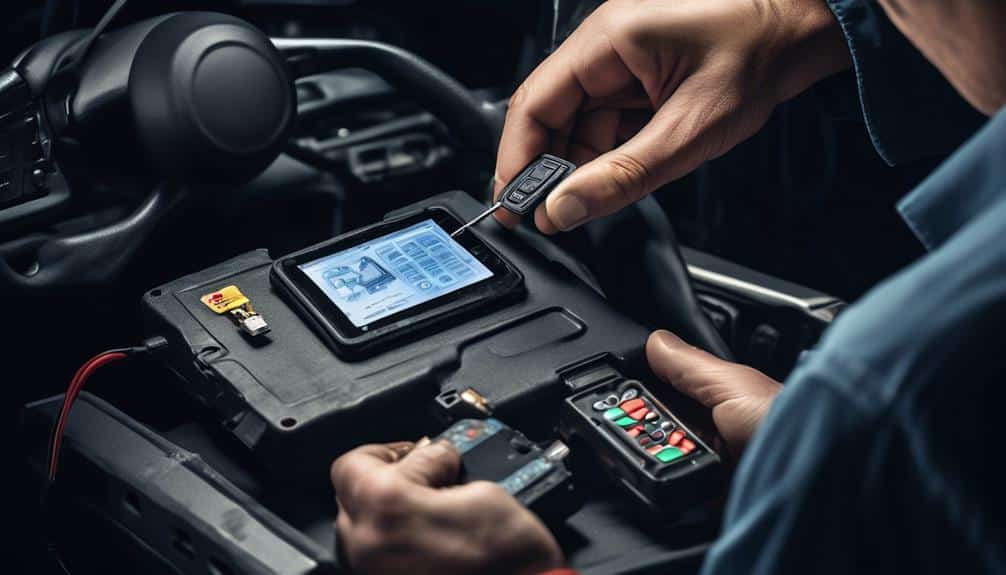
To program a transponder chip, you'll need to follow a step-by-step process that ensures precise and accurate programming. Here are the steps to program a transponder chip:
- Obtain the transponder chip code: Start by obtaining the unique code for the transponder chip that needs programming. This code is usually provided with the transponder chip replacement or can be obtained from the vehicle manufacturer.
- Access the programming mode: Use a specialized programming tool or software to access the programming mode of the vehicle's onboard computer system. This mode allows you to communicate with the transponder chip and program it accordingly.
- Program the transponder chip: Once in the programming mode, follow the instructions provided by the programming tool or software to program the transponder chip. This typically involves entering the unique code and confirming the programming process.
Testing and Verification
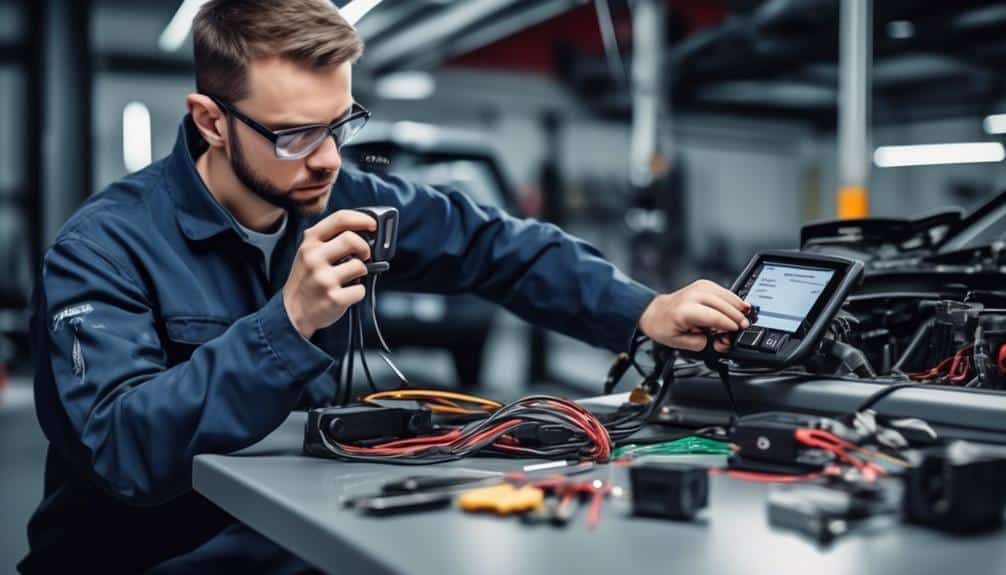
Testing and verification play a crucial role in ensuring the successful programming of a transponder chip. These processes are essential to identify any errors or issues that may arise during the key programming procedure. To ensure accurate programming, various testing methods are employed.
One commonly used testing method is the functional test, where the remote key is tested for its functionality after programming. This involves verifying that the transponder chip is correctly programmed and can effectively communicate with the vehicle's immobilizer system. Additionally, the functionality of the remote key's buttons, such as locking and unlocking the doors, should also be tested.
Another important aspect of testing is error handling. During the programming process, errors can occur due to various reasons, such as incorrect key codes or communication failures. Proper error handling techniques should be implemented to detect and address these errors. This may involve providing clear error messages to guide the technician in resolving the issue or implementing automatic error correction procedures.
Final Programming Steps
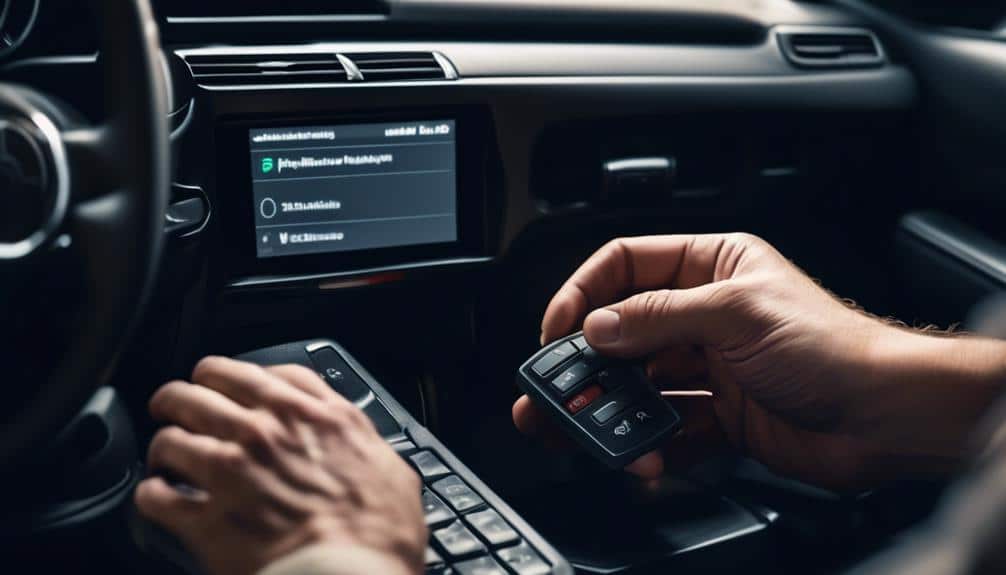
To complete the remote key programming process, follow these final steps:
- Perform a remote key functionality check: After programming the remote key, it's important to ensure that it's functioning properly. Test the various functions of the remote key, such as locking and unlocking the doors, opening the trunk, and activating the alarm. This step will verify that the programming was successful and the remote key is ready for use.
- Test the remote key range: Once the remote key functionality check is complete, it's crucial to test the range of the remote key. Walk away from the vehicle while pressing the buttons on the remote key. Observe if the vehicle responds to the commands from a reasonable distance. If the range isn't satisfactory, it may indicate a weak battery or a problem with the remote key itself.
- Secure and store the remote key: After ensuring that the remote key is working properly, it's essential to secure and store it in a safe place. Keep the remote key in a location where it's easily accessible, but also protected from damage or loss. It's advisable to have a spare remote key in case of emergencies.
Remote Key Functionality Check
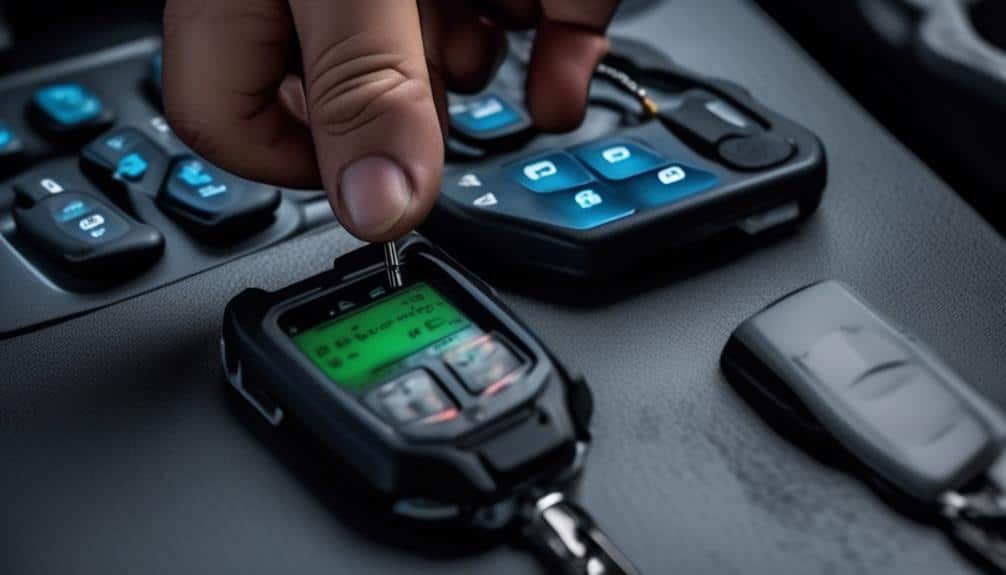
Perform a thorough functionality check of the remote key to ensure proper operation. After completing the final programming steps, it's crucial to verify that the remote key is functioning correctly. This step is essential to ensure that the remote key signal is being transmitted and received accurately.
To begin the remote key functionality check, stand within a reasonable distance from the vehicle and press each button on the remote key. Observe if the vehicle's doors lock and unlock accordingly. Additionally, check if the remote key can activate any other features, such as the trunk release or the panic alarm.
If any button fails to trigger the desired response, consult the troubleshooting guide provided by the manufacturer. The troubleshooting guide will provide specific instructions on how to address potential issues with the remote key. It's important to follow these instructions carefully to effectively resolve any problems and ensure the remote key's proper functioning.
Customer Satisfaction and Payment

Once the remote key functionality check is complete, ensuring customer satisfaction and processing the payment is the next step in the remote key programming process.
To achieve this, follow these steps:
- Gather customer feedback: After programming the remote key, ask the customer if they're satisfied with the results. Address any concerns or questions they may have and make sure they understand how to use the newly programmed key. This step is crucial to ensure the customer's satisfaction and to provide a positive experience.
- Discuss payment options: Inform the customer about the available payment options and provide them with a clear breakdown of the cost for the remote key programming service. Offer flexibility by accepting various payment methods, such as cash, credit card, or mobile payment apps. Ensure that the customer understands the payment process and is comfortable with the chosen option.
- Process the payment: Once the customer has made their payment, generate an invoice or receipt for their records. Make sure to provide accurate and detailed documentation of the transaction. Thank the customer for their business and assure them that you're available for any future assistance they may need.
Frequently Asked Questions
How Long Does the Remote Key Programming Process Usually Take?
The remote key programming process typically doesn't take too long. It's a fairly quick and straightforward task. The duration of the process may vary depending on the specific circumstances, but it generally doesn't require a significant amount of time.
However, it's important to note that the time required for remote key programming isn't the only factor to consider. You should also consider the cost of the service and the tools used for remote key programming.
Can a Remote Key Be Programmed for Any Type of Vehicle?
Remote key programming options may vary depending on the vehicle's make and model. Not all remote keys are compatible with every type of vehicle. It's important to check the manufacturer's guidelines or consult with a professional to determine if your remote key can be programmed for your specific vehicle.
Different vehicles may have different processes for remote key programming, so it's advisable to seek expert assistance to ensure proper programming and functionality.
What Happens if the Remote Key Programming Equipment Malfunctions During the Process?
If the remote key programming equipment malfunctions during the process, don't worry, there are troubleshooting steps you can take.
First, check the connections and make sure everything is properly plugged in.
If that doesn't resolve the issue, try restarting the equipment.
If all else fails, there are alternative solutions available. You can contact a professional locksmith or the dealership to seek their assistance.
It's always helpful to have a backup plan in case of equipment malfunctions.
Is It Possible to Program a Remote Key for a Vehicle That Has a Damaged or Broken Ignition?
Yes, it's possible to program a remote key for a vehicle with a damaged or broken ignition. This can be done without the original key.
The process involves using specialized equipment to access the vehicle's immobilizer system and program the new remote key. However, it's important to note that this task requires technical expertise and should be performed by a professional locksmith or an authorized dealer.
Are There Any Risks or Potential Issues Associated With Remote Key Programming?
When it comes to remote key programming, you might be wondering about the risks or potential issues involved.
Well, let me assure you that while there can be some challenges, they're easily overcome by professionals who are well-versed in the process.
With their expertise, they can navigate any potential issues that may arise, ensuring a successful programming experience.
